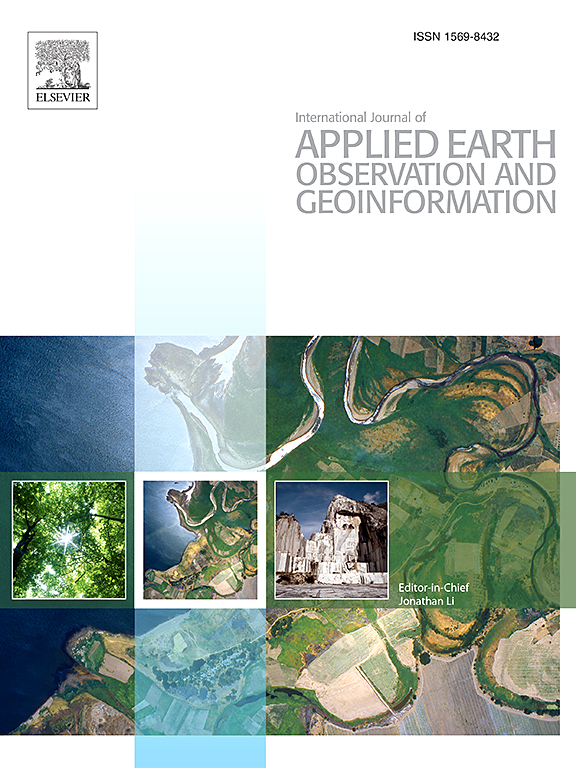Terrain and individual tree vertical structure-based approach for point clouds co-registration by UAV and Backpack LiDAR
IF 7.6
Q1 REMOTE SENSING
International journal of applied earth observation and geoinformation : ITC journal
Pub Date : 2025-05-01
DOI:10.1016/j.jag.2025.104544
引用次数: 0
Abstract
Tree-level structural parameters estimation plays a key role in the researches and practice in sustainable forest management, carbon storage estimation, as well as ecological function evaluation. However, single Light Detection and Ranging (LiDAR) platform exhibits limitations when acquiring complete (i.e., including over-story and under-story) point cloud data for forest stands, e.g., UAV LiDAR systems tend to overlook details of the tree trunk or the lower ground, while Backpack LiDAR systems struggle to capture the treetop, etc. The limited shared features of point clouds from UAV and Backpack LiDAR sensors also pose challenges in the accurate registration and merging of these datasets. In this study, we proposed a marker free automatic registration framework for multi-platform forest point clouds with terrain features. The framework comprised three key stages: first, a curvature-adaptive weighting mechanism was adapted to optimized the Fast Point Feature Histogram (FPFH) descriptors for initial coarse registration, utilizing terrains features. Second, individual tree positions were extracted from each platform’s LiDAR dataset and employed as key feature points for matching. Third, a similarity function was constructed to evaluate the most geometrically consistent point correspondences across platforms, which were subsequently refined through an Iterative Closest Point (ICP) algorithm. Furthermore, a voxel-based denoising algorithm that integrated point density with vertical connectivity was developed to identify and filter out noise from the backpack LiDAR data—specifically, non-structural elements such as branches and shrubs. This denoising process laid a robust foundation for accurately locating individual tree centers. Additionally, a layer-wise adaptive circular fitting method was introduced for determining trunk positions. By clustering trunk point clouds at successive vertical layers, this method yielded precise estimates of straight, individual tree trunk centers for use in subsequent registration steps. The proposed framework achieved a registration accuracy of RMSE = 0.098–0.134 m across diverse forest types and terrain conditions, demonstrating its robustness and applicability in complex environments. This facilitated the integration of UAV and backpack LiDAR technologies in forestry resource monitoring. Using the fused point cloud data, tree-level structural parameters estimation of diameter at breast height (RMSE = 1–1.2 cm), tree height (RMSE = 0.29–0.55 m).
基于地形和单树垂直结构的无人机与背包式激光雷达点云配准方法
树级结构参数估算在森林可持续经营、碳储量估算、生态功能评价等方面的研究和实践中发挥着关键作用。然而,单光探测和测距(LiDAR)平台在获取完整的森林林分点云数据(即,包括层上和层下)时显示出局限性,例如,无人机激光雷达系统倾向于忽略树干或较低地面的细节,而双肩包激光雷达系统则难以捕获树顶等。无人机和双肩包激光雷达传感器的点云共享特征有限,这也给这些数据集的准确配准和合并带来了挑战。本文提出了一种基于地形特征的多平台森林点云无标记自动配准框架。该框架包括三个关键阶段:首先,采用曲率自适应加权机制优化快速点特征直方图(FPFH)描述符,利用地形特征进行初始粗配准;其次,从每个平台的LiDAR数据集中提取单个树的位置,并将其作为关键特征点进行匹配。第三,构建相似性函数来评估各平台之间几何上最一致的点对应关系,随后通过迭代最近点(ICP)算法对其进行细化。此外,研究人员还开发了一种基于体素的去噪算法,该算法将点密度与垂直连通性相结合,用于识别和过滤背包激光雷达数据中的噪声,特别是树枝和灌木等非结构元素。这种去噪过程为准确定位单个树中心奠定了坚实的基础。此外,还引入了一种分层自适应圆形拟合方法来确定主干位置。通过对连续垂直层的树干点云进行聚类,该方法可以精确估计出笔直的单个树干中心,以便在后续配准步骤中使用。该框架在不同森林类型和地形条件下的配准精度RMSE = 0.098 ~ 0.134 m,显示了其在复杂环境下的鲁棒性和适用性。这促进了无人机和双肩式激光雷达技术在林业资源监测中的整合。利用融合点云数据,估算树级结构参数胸径高度(RMSE = 1-1.2 cm)、树高(RMSE = 0.29-0.55 m)。
本文章由计算机程序翻译,如有差异,请以英文原文为准。
求助全文
约1分钟内获得全文
求助全文
来源期刊

International journal of applied earth observation and geoinformation : ITC journal
Global and Planetary Change, Management, Monitoring, Policy and Law, Earth-Surface Processes, Computers in Earth Sciences
CiteScore
12.00
自引率
0.00%
发文量
0
审稿时长
77 days
期刊介绍:
The International Journal of Applied Earth Observation and Geoinformation publishes original papers that utilize earth observation data for natural resource and environmental inventory and management. These data primarily originate from remote sensing platforms, including satellites and aircraft, supplemented by surface and subsurface measurements. Addressing natural resources such as forests, agricultural land, soils, and water, as well as environmental concerns like biodiversity, land degradation, and hazards, the journal explores conceptual and data-driven approaches. It covers geoinformation themes like capturing, databasing, visualization, interpretation, data quality, and spatial uncertainty.
 求助内容:
求助内容: 应助结果提醒方式:
应助结果提醒方式:


